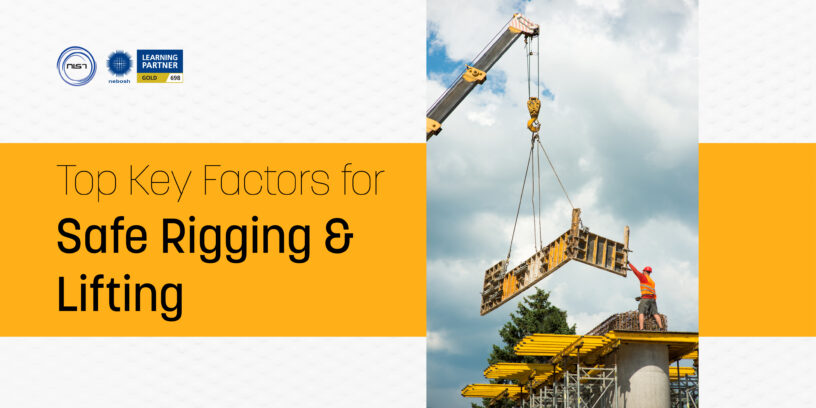Workers in industrial rigging and lifting must handle a variety of materials and equipment on a daily basis, as well as arrange and assemble massive structures. Workers are frequently required to work in hazardous conditions, where each operation may present its unique set of challenges. Both workers and employers recognise that industrial rigging is a dangerous job. We have read and heard of numerous incidents in which improper rigging practises have resulted in the injuries and deaths of numerous workers. Such accidents still continue to occur.
This is frequently due to insufficient knowledge and training provided to riggers and other operational personnel. However, with appropriate planning, these jobs can be completed without causing any danger to the worker or damage to the equipment. Industrial workers must be aware of suitable methods of carrying out operations, rigging techniques and equipment, securing loads, the implications of overloading rigging devices beyond their capability, and dealing with unpredictable moving machinery.
Riggers and anyone in charge of handling heavy machinery and equipment must be:
- Competent to complete specified responsibilities
- Adequately trained to recognise and detect any hazards associated with the specified assignment
- Be aware of the surface conditions in which loading/lifting equipment is used. It should be noted that the surface must be even and strong enough to hold not only the lifting equipment, but also the load. It is preferable to avoid loading unneeded items and objects that could injure workers if they are impacted.
- Aware of rigging techniques and equipment handling (e.g., slings, shackles, hooks, hoist, and blocks).
- Understanding of the link between load weight and rated capacity of rigging gear and lifting equipment
- Capable of anticipating issues before they occur, hence avoiding unfavourable outcomes. While performing any particular duty, they must follow all necessary processes.
Precautions with Rigging Gear and Equipment
Riggers should properly inspect their rigging gear and equipment at the start of each shift and before picking up where they left off in order to reduce the likelihood of equipment failure. Several safety measures for managing machines include:
- Under no circumstances should the crane or rigging equipment be overloaded. They might break, the crane might go over, or it might get damaged if you do that.
- Make it a point to throw away any equipment or gear that is found to be defective right away. Utilising such equipment is problematic.
- Inspections of the rigging and apparatus should look for things like bent or sprung hooks brought on by overloading, as well as kinks, broken strands, and frayed areas in wire rope slings and stretched links in chain slings.
Safe Lifting Techniques
There are three main considerations to take into account while lifting a load securely, in addition to choosing the appropriate sling and utilising it properly to hold and move a suspended object.
1. Make a level lift
A load’s centre of gravity may hold the majority of its weight. You must place the hoist hook directly above the centre of gravity in order to perform a level lift. If the hoist hook is placed too far away from it, the load may tilt dangerously and become unbalanced. Due to the load’s weight being distributed unevenly, the slings will also be stressed. Therefore, it is crucial to make a level shift.
2. Focus on the Rated Capacity of the Sling
In most cases, the rated capacity of the sling is mentioned in the manufacturer’s catalogue so that workers are aware of it. It is determined by the material of the sling, its size, and the type of hitch. It is best not to exceed the rated capacity. When sling damage to the rope is of minor or no relevance to the lifting of the load, then, alloy steel chains, wire ropes, and fibre rope slings are usually employed. When sling damage is unacceptably high, synthetic web slings are recommended.
3. Training & Expertise
The leading causes of workplace accidents and injuries are a lack of sufficient training and expertise in handling and using slings. To avoid dangerous situations, it is best to follow the manufacturer’s catalogues and instruction manuals, which include suggestions for correct usage, maintenance, and extending the life of the lifting gear and equipment.
Conclusion
There is no replacement for being aware and having appropriate and proper training when it comes to being safe while handling big gear and equipment. Being aware of the aforementioned elements should provide you with a perspective on certain aspects of safe rigging and lifting.
At NIST Global, we offer industry specific Lifting and Rigging training program that will help your workers to gain in-depth knowledge on best safe practices of Lifting & rigging. We have Industrial experts who carry robust field experience in Lifting & Rigging Training; their training have enabled leading companies to perform safe lifting & rigging & prevent any injuries or loss of life / property.
For further details, kindly call our corporate team @ 91 8754465588 or mail us @ info@nistglobal.com














Leave a Reply